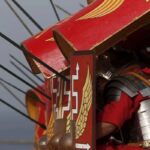Calceus is a typical Roman shoe that played a key role not only as foot protection but also as a marker of social position. It was a shoe that covered the entire foot, tied at the ankle and at the front, made of durable leather, often dyed in characteristic colours reflecting the status of its owner.
For patricians, the highest social class in ancient Rome, calcei dyed red were reserved. The newly appointed senators wore classic black shoes. The colours were not accidental – purple and red were associated with power, prestige and ceremonial events, which emphasized the role and position of the person wearing these shoes.
Calcei were also associated with public functions. Roman senators, who were obliged to wear a toga, also had to put on appropriate footwear, called calcei senatorius. These shoes, made of black leather, had four straps (corrigiae), which further emphasized their dignified character. In some cases, they may have worn shoes with higher soles on special occasions, which gave them extra height and dignity.
Interestingly, the Romans often imported materials and leatherworking techniques from other countries, including Greece and Babylonia, which influenced the development and diversity of Roman footwear. The Calceus, as a classic element of citizens’ wardrobe, was a symbol not only of wealth but also of political power, as well as an indicator of civic duty in Roman society.
This type of shoe, apart from its elegant form, also had a practical use. It protected the feet from harsh weather conditions and was suitable for both casual and formal occasions. With a solid construction of several layers of leather, calcei were comfortable and durable, making them a popular choice among Roman citizens.







